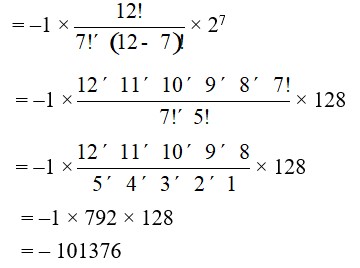Ncert Solutions Maths class 11th
Get insights from 1.6k questions on Ncert Solutions Maths class 11th, answered by students, alumni, and experts. You may also ask and answer any question you like about Ncert Solutions Maths class 11th
Follow Ask QuestionQuestions
Discussions
Active Users
Followers
New answer posted
5 months agoContributor-Level 10
4. Let a5b7 occurs in (r + 1)th term of [removed]a – 2b)12.
Now, Tr+1 = 12Cra12-r (–2b)r
= (–1)r12Cra12–r . 2r. br
Comparing indices of a and b in Tr-1 with a5 and b7 we get, r = 7
So, co-efficient of a5b7 is (–1)712C7 27

New question posted
5 months agoNew question posted
5 months agoNew answer posted
5 months agoContributor-Level 10
2. 
By binomial theorem,
(a + b)n = nC0 (a)n (b)0 + nC1 (a)n–1 (b)1 + …………. + nCr (a)n–r (b)r + …………… + nCn (a)n–n (b)n
Where, b0 = 1 = an–n
So, (a + b)n = nCr (a)n–r (b)r
Putting a = 1 and b = 3 such that a + b = 4, we can rewrite the above equation as
(1 + 3)n = nCr (1)n–r.3r
=>4n = .nCr
Hence proved.
New answer posted
5 months agoContributor-Level 10
1. For a number x to be divisible by y, we can write x as a factor of y i.e., x = ky where k is some natural number. Thus in order for 9n+1 – 8n – 9 to be divisible by 64 we need to show that 9n+1 – 8n – 9 = 64k where k is some natural number.
We have, by binomial theorem
(1 + a)m = mC0 + mC1 (a) + mC2 (a)2 + mC3 (a)3 + ………… + mCm (a)m
Putting, a = 8 and m = n + 1
(1 + 8)n+1 = n+1C0 + n+1C1.8 + n+1C2.82 + n+1C3.83 + ……. + n+1Cn+1. (8)n+1
=> 9n+1= 1 + (n + 1)8 + 82* [n+1C2 + n+1C3.8 + ………. + n+1Cn+1. (8)n+1–2] [since, n+1C0 = 1, n+1C1= n + 1]
=> 9n+1 = 1 + 8n + 8 + 64 * [n+1C2 + n+1C3.8 + ……�
New question posted
5 months agoNew answer posted
5 months agoContributor-Level 10
24. Let P (n) be the statement “ 2n+7< (n+3)2
ofn=1
P (1): 2
9<16 which is true. This P (1) is true.
Suppose P (k) is true.
P (k)= 2k+7< (k+3)2 . (1)
Lets prove that P (k +1) is also true.
“ 2 (k + 1) + 7 < (k + 4)2=k2+ 8k + 16”
P (k +1) = 2 (k +1) +7 = (2k +7) +2
< (k +3)2+ 2 (Using 1)
= k2+ 9 + 6k +2 = k2+6k +11
Adding and subtracting (2k + k) in the R. H. S.
for all
is true.
By the principle of mathematical induction, P (n)is true for all n N.
New answer posted
5 months agoContributor-Level 10
23. Let
Put n= 1,
is a multiple of 27.
Which is true.
Assume that P(k) is true for some natural no. k.
P(k)= be a multiple of 27
i.e,
(1)
We want to prove that P(k+1) is also true.
Now,
(Using 1)
is true when P(k) is true.
Hence, by P.M.I. P(n) is true for every positive integer n.
New answer posted
5 months agoContributor-Level 10
22. Let P(n): is divisible by 8
put n= 1,
P(1):
34 – 8 – 9 = 81– 17 = 64= is divisible by 8
Which is true.
Assume that P(k) is true for some natural numbers k.
i.e, be divisible by 8
where,a
(1)
We want to prove thatP(k+ 1) is true.
is divisible by 8, is also true.
Now,
=
3(2k +2). 32 8k 17
(Using 1)
= 72a + 64k+ 64 = 8(9a + 8k + 8)
= 8b, where b = 9a + 8b + 8
32k + 4– 8(k+1) – 9 is divisible by 8.
P(k+1) is true when P(k) is true. Hence, By P.M.I. P(n) is true for all positive integer n.
New answer posted
5 months agoContributor-Level 10
21. Let
Assume that P(k) is true for some natural no. k
i.e.
Now, let us prove P(k +1) is true.
Hence, by P.M.I. P(n) is true for all natural number i.e.
Taking an Exam? Selecting a College?
Get authentic answers from experts, students and alumni that you won't find anywhere else
Sign Up on ShikshaOn Shiksha, get access to
- 65k Colleges
- 1.2k Exams
- 679k Reviews
- 1800k Answers
